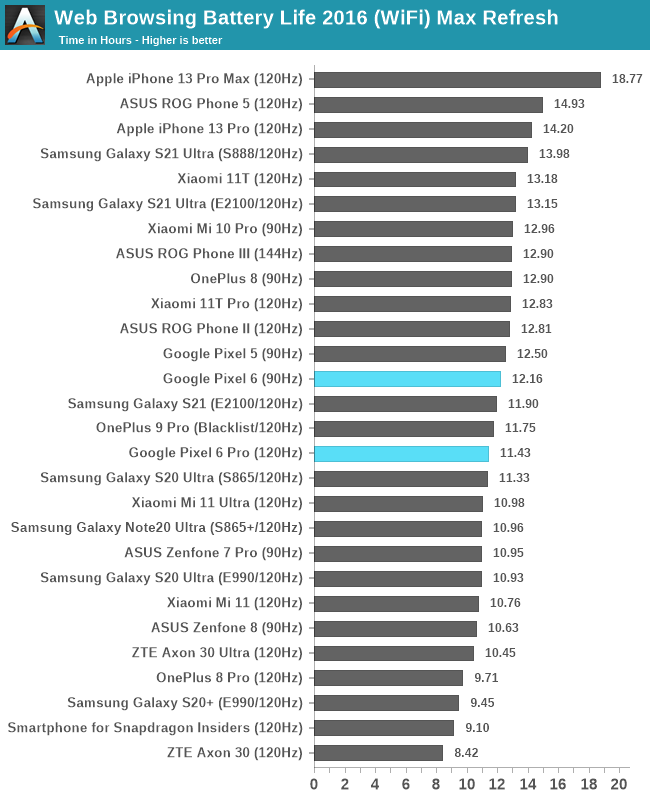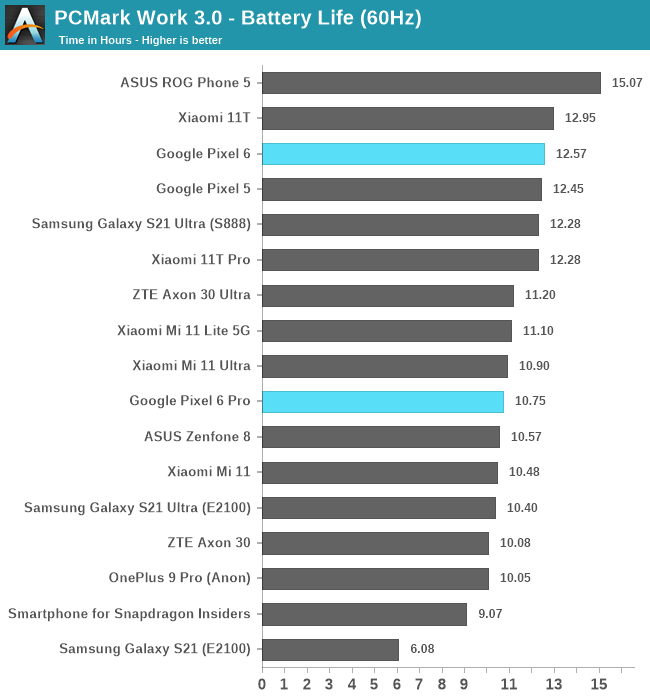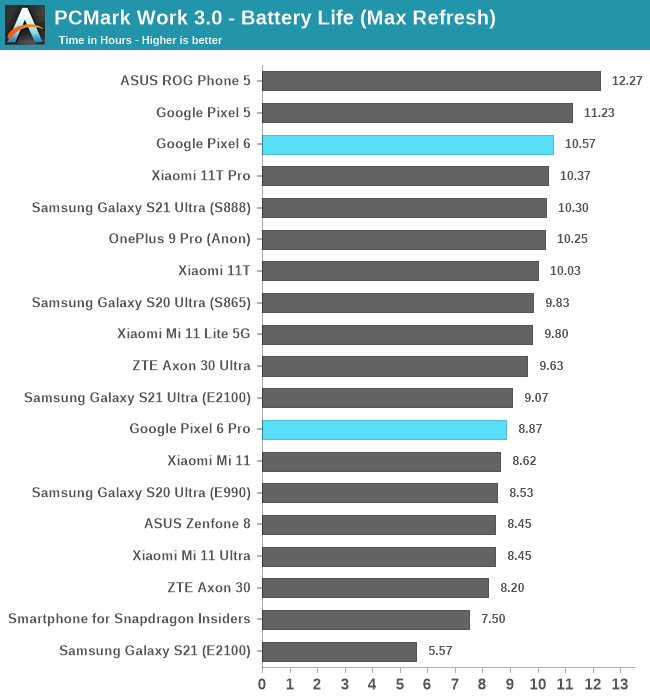Google's Tensor inside of Pixel 6, Pixel 6 Pro: A Look into Performance & Efficiency
by Andrei Frumusanu on November 2, 2021 8:00 AM EST- Posted in
- Mobile
- Smartphones
- SoCs
- Pixel 6
- Pixel 6 Pro
- Google Tensor
Phone Efficiency & Battery Life
While not directly released to the Google Tensor, I also finished running the various battery tests for the Pixel 6 and Pixel 6 Pro, and there are some remarks to be made in regards to the power efficiency of the devices, and how the new SoC ends up in relation to the competition.
As a reminder, the Pixel 6 comes with a 4614mAh battery and a 6.4” 1080p 90Hz OLED screen, while the Pixel 6 Pro features a 5003mAh battery and a 6.71” 1440p 120Hz OLED display, with variable refresh rate from 10-120Hz.

Starting off with the 60Hz web browsing results, both Pixel phones end up extremely similar in their longevity, at 14 hours runtime. The regular Pixel 6 is hard to compare things to as we don’t have too many recent phones with 90Hz displays in our results set, however the Pixel 6 Pro should be a direct comparison point to the S21 Ultras, as both feature 5000mAh batteries and similar display characteristics. The P6Pro here ends up slightly ahead of the Exynos 2100 S21 Ultra, which might not be too surprising given that the Tensor chip does end up at somewhat lower CPU power levels, even if performance is lower. It’s still quite behind the Snapdragon 888 variant of the S21 Ultra – which is again quite representative of the SoC efficiency differences.

Running the phones at their respective max refresh rates, both devices see larger drops, however the Pixel 6 Pro especially sees a more substantial hit. This time around, the 6 Pro ends up significantly behind the Exynos 2100 S21 Ultra, which had only a minor drop in the 60 -> 120Hz results.

Shifting over to PCMark at 60Hz, we see that there’s a larger difference in favour of the Pixel 6, as the Pixel 6 Pro ends up behind it in longevity by almost two hours. The 6 Pro still ends up in line with the E2100 S21U, however that device showcases significantly higher performance numbers in the test, which acts both as a performance metric for device responsivity as well as a battery life test.

At 120Hz, the 6 Pro ends up worse than the E2100 S21U, and quite worse than the S888 S21U.
When I was investigating the phones, the 6 Pro’s power behaviour was quite weird to me, as I saw best-case baseline power figures of around 640mW, and sometimes this inexplicably would also end up at 774mW or even higher. What this reminded me of, was the power behaviour of the OnePlus 9 Pro, which also suffered from extremely high baseline power figures. Both the 6 Pro and the 9 Pro advertise themselves as having LPTO OLED panels, but both of them very clearly do not behave the same as what we’ve seen on the Note20Ultra or the S21Ultra phones. The 6 Pro also only goes up to up to 750 nits 100% APL peak brightness in auto-brightness mode under bright ambient light, which is significantly lower than the S21U’s 942 nits. I think what’s happening here is that the Pixel 6 Pro simply doesn’t have the most state-of-the-art display, and thus is quite less efficient as what we find on the competition. It does kind of make sense for the price-point of the phone, but also explains some of the battery behaviour.
Naturally, the Tensor SoC also just doesn’t appear to be as efficient. Particularly many UI workloads would be run on the A76 cores of the chip, which just outright have a 30% perf/W disadvantage. The phone ends up OK in terms of absolute battery life, however performance metrics are lower than other devices.
I think the regular Pixel 6 here is just a much better device as it doesn’t seem to have any particular issues in display efficiency, even if it’s just a 1080 90Hz panel. There are naturally experience compromises, but it’s also a $599 phone, so the value here is very good.
US readers who are used to Qualcomm phones might also encounter efficiency regressions when under cellular data – we abandoned doing testing here many years ago due to the impossible task to get consistent test environments.










108 Comments
View All Comments
sharath.naik - Saturday, November 13, 2021 - link
Looks like you both do not value to concept of understanding the topic before responding, So pay attention this time. I am talking about hardware binning.. not software binning like every one else does for low light. Hardware binning means the sensors NEVER produce anything other than 12MP. Do both of you understand what NEVER means? Never means these sensors are NEVER capable of 50MP or 48MP. NEVER means Pixel 3x zoom are 1.3MP low resolution images(Yes that is all your portrait modes). NEVER means at 10x Pixel images are down to 2.5MP.Next time Both of you learn to read, learn to listen before responding like you do.
meacupla - Tuesday, November 2, 2021 - link
IDK about you, but livetranslation is very useful if you have to interact with people who can't speak a language you can speak fluently.BigDH01 - Tuesday, November 2, 2021 - link
Agreed this is useful in those situations where it's needed but those situations probably aren't very common for those of us that don't do a lot of international travel. In local situations with non-native English speakers typically enough English is still known to "get by."Justwork - Friday, November 5, 2021 - link
Not always. My in-law just moved in who knows no English and I barely speak their native language. We've always relief on translation apps to get by. When I got the P6 this weekend, both our lives just got dramatically better. The experience is just so much more integrated and way faster. No more spending minutes pausing while we type responses. The live translate is literally life changing because of how improved it is. I know others in my situation, it's not that uncommon and they are very excited for this phone because of this one capability.name99 - Tuesday, November 2, 2021 - link
Agreed, but, in the context of the review:- does this need to run locally. (My guess is yes, that non-local is noticeably slower, and requires an internet connection you may not have.)
- does anyone run it locally (no idea)
- is the constraint on running it locally and well the amount of inference HW? Or the model size? or something else like CPU? ie does Tensor the chip actually do this better than QC (or Apple, or, hell, an intel laptop)?
SonOfKratos - Tuesday, November 2, 2021 - link
Wow. You know what the fact that the phone has a modem to compete with Qualcomm for the first time in the US is good enough for me. The more competition the better, yes Qualcomm is still collecting royalties for their parents but who cares.Alistair - Tuesday, November 2, 2021 - link
That's a lot of words to basically state the truth, Tensor is a cheap chip, nothing new here. Next. I'm waiting for Samsung + AMD.Alistair - Tuesday, November 2, 2021 - link
phones are cheap too, but too expensiveWrs - Tuesday, November 2, 2021 - link
Surprisingly large for being cheap. Dual X1's with 1 MB cache, 20 Mali cores. So many inefficiencies just to get a language translation block. As if both the engineers and the bean counters fell asleep. To be fair, it's a first-gen phone SoC for Google.Idk if I regard Samsung + AMD as much better, though. Once upon a time AMD had a low-power graphics department. They sold that off to Qualcomm over a decade ago. So this would probably be AMD's first gen on phones too. And the ARM X1 core remains a problem. It's customizable but the blueprint seems to throw efficiency out the window for performance. You don't want any silicon in a phone that throws efficiency out the window.
Alistair - Wednesday, November 3, 2021 - link
Will we still be on X1 next year? I hope not. I'm hoping next year is finally the boost that Android needs for SoCs.